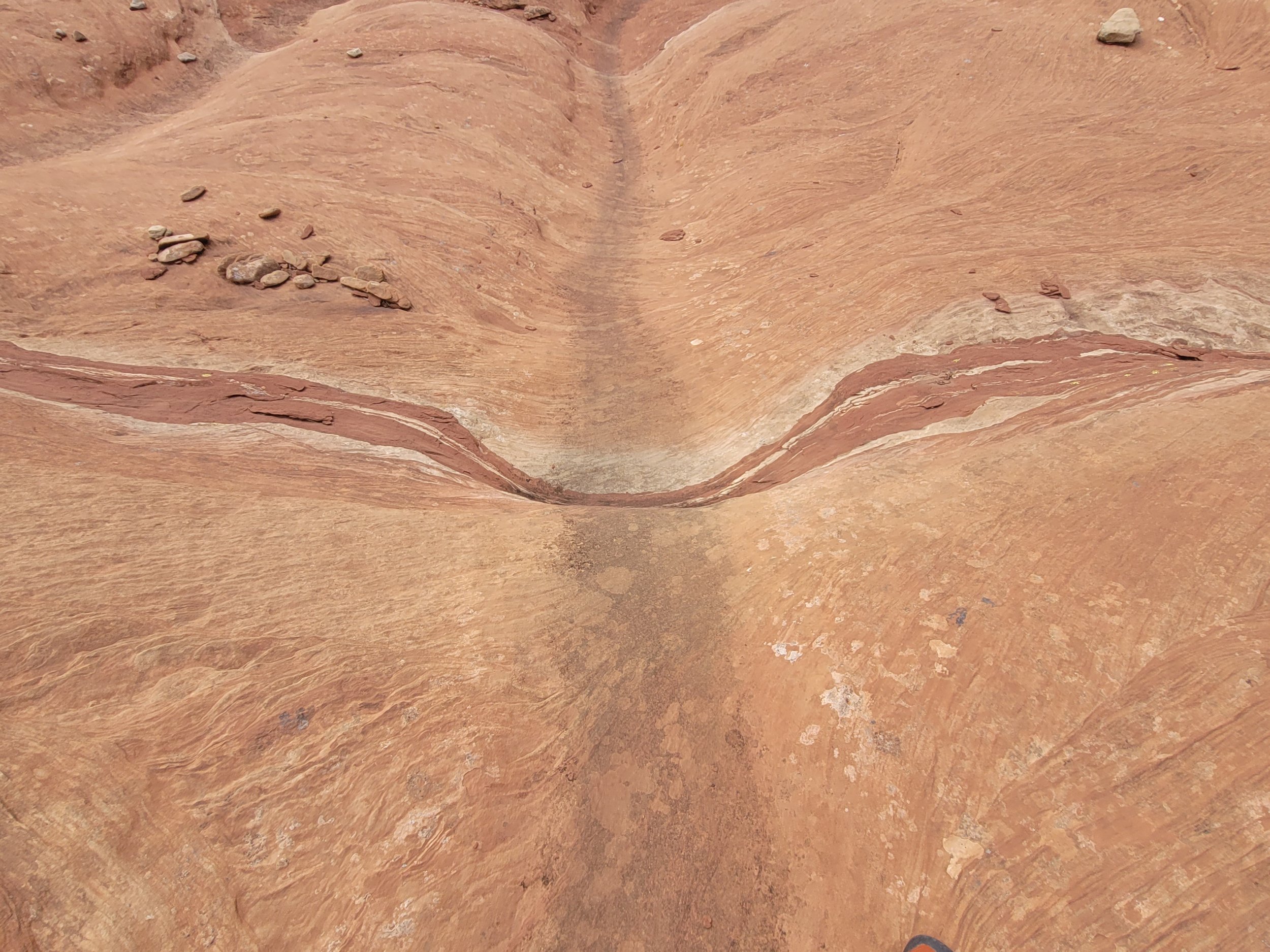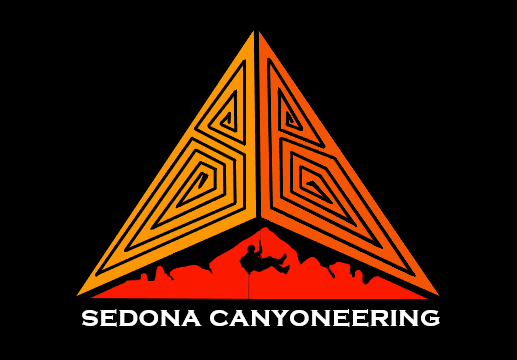Using The Guide
Due to a heavy increase in the sport of canyoneering, this guide has been created as a canyoneering resource specific to the Red Rock Region of Sedona, Arizona. Increased awareness of Sedona Canyoneering standards, ethics, risks, and low impact techniques are provided and aimed to keep Sedona a safe and enjoyable canyoneering destination. Updated gps tracks, satellite maps, and detailed approach descriptions are freely provided to reduce the impact on the environment. Our goal is to preserve and protect this sacred landscape by providing these tools and information, along with increasing awareness of environmental and safety concerns relative to the area.

The Beta
The organization of the information provided in this guide will be covered in detail to help you easily find what you need.
Each technical route page will start with basic information needed to safely complete the route. Measurements are never exact, but are approximated to the best of our knowledge.
Route Descriptions
From Top to Bottom:
The Route Name- The name most commonly used by the canyon community
The Region- Trailhead or sub-region within the Red Rock Region of Sedona, Arizona
Distance- Approximate total mileage and elevation gain from car to car.
Duration- Estimated time frame based on averages from multiple trip logs. Time required will vary based on group size, experience, condition, and other factors.
Difficulty- Easy, Moderate, Hard, Hardest
ACA Rating- All of the routes described in the Red Rock Region are rated 3A meaning they are typically dry and require ropes to complete. More about the ACA Rating system can be found on their website.
Longest Rappel- The Longest Rappel length like others provided is approximate and never absolute. Anchors and locations change over time due to environmental impact and maintenance/ manipulation.
Gear- The minimum amount of rope needed to safely descend the route.
Anchor Materials- Estimated materials required to set ALL anchors on the route if needed.
Parking- The recommended parking locations will be provided. Annual National Parks Passes are accepted, and Red Rock passes can be purchased at the trailhead kiosk or the Sedona Visitor Center.
Overview- A short description of the route and what it has to offer.
Approach- Detailed approach descriptions will help you find the route and are best used in conjunction with a GPS device. Some routes will feature multiple approach options or shuttle recommendations.
Descent- A short description of the descent, anchors, and rappels. Rappel lengths are approximate and based on the best of our knowledge.
Exit- A brief description of the Exit best used in conjunction with a GPS device.
Most exits sound something like.. “Follow the drainage to the trail and back to your vehicle.”
Coordinates- Turnoff and 1st Rappel coordinates are provided to help keep you on track.
Link-ups- Two or more routes that can be combined for a full value day. Most adventurers are visiting from somewhere else and it took them some work to get here. Link ups are the best way to capitalize on your time in the red rocks.
Local recommendations, preservation tips, low impact practices may be displayed at the bottom of the route description.
Canyon Lingo
A short overview of common terms found in this guide.
Approach- The hike to the start of the canyon or route.
Bench- A bench is characterized by a flat plateau above steep terrain. ex. take the gully up to the first bench
Buddy Check- The practice of checking rigging and safety procedures before getting on rappel.
Chokestone- A large boulder that has become wedged and stuck in place.
Coconino- The white rock or top layer of sandstone.
Exit- The hike from the technial section to the parking lot.
Free Hanging rappel- A free hanging rappel (A.K.A Free-hanger) is a rappel where you have no contact with the wall and are hanging in the air. Free hanging rappels are common and may require a higher friction setting depending on weight and comfort.
Gully- A steep or bushy break in the sandstone. Gully’s are often referred to in approach beta as they are well traveled and grant access to the higher benches above.
LDC- Left Down Canyon
Multi-stage rappel- A rappel in which you transitions from free hanging, to on wall, and may have multiple ledge systems. It may be important to note multistage rappels so canyoneers do not get off rope on the wrong ledge or pass the anchor.
On wall rappel- A rappel in which your feet have contact with the wall. These are often good introductory rappels for beginners.
Overhung rappel- Over hung rappels usually have aggressive edge transitions at the start and typically drop into a free hanging rappel. These rappels are undercut and often result in awkward starts and fast rappels.
R0- R-Zero is the term applied to anchor location that is not always a mandatory rappel and may not have an anchor in place. R0 are usually rappels that are put in place to easier access the start of the route or bypass an obstacle. Ex. R0- off Large tree or downclimb LDC. or R0 during icy or wet conditions.
R1- The approximate location of the first anchor. Existing anchors or anchor sources should be available near this location.
Rockslide Gully- A gully filled with large boulders and debris. Rockslide gully’s will require extra caution and effort to ascend.
RDC- Right Down Canyon
Retrievable Anchor- An anchor designed that can be retrieved, using this style has evolved into a practice to minimize impact. When a retrievable anchor (A.K.A- toggle, fiddle stick etc..) is used the rope does not have to be pulled through the anchor reducing the effect of rope grooves and damage to your gear.
Scree- Scree or scree pile refers to small loose rock, usually in abundance and often on a slope
Social Trails- A collection of existing game and “local” trails that may not appear on maps and at times may be faint or hard to follow.
Turnoff- The estimated location where one would leave a trail and connect with a social trail or drainage.
Traverse- To move sideways.
Type-2- A classification of the type of fun one experiences on their adventure, that can be defined as “difficult and unpleasant at the time, but fun and rewarding when you’ve completed it.” Type 2 adventures will test your skills and limits; and therefore are not recommended for the casual rappeler.
Trailing the rope- This is the practice of taking the rope to the edge or down the rappel in order to avoid trees, other adventurers, and archaeological sites. Blindly throwing the rope over the edge can lead to mishaps, retrieval issues, environmental damage, and hiker related incidents.
TH- The letter TH are often used to as an abbreviation for the trailhead or parking location for the route.
Difficulty Ratings
Our difficulty ratings are based on the amount of effort required to complete each route and is relative to the Sedona Red Rock Region.
Canyoneering and adventure routes vary in duration and difficulty. Having explored other routes and regions in Northern Arizona I would say the routes described in this region are comparably less committing, technical, and difficult than its nearby rugged and remote neighbors. The physical requirements of the approach, route and exit described in this book will also be taken into consideration. Difficulty will be broken into one of 4 categories:
EASY
“Easy” routes are often shorter in duration, distance, and overall difficulty. Easy routes are expected to take a few hours, are usually less than 5 miles, and require basic route-finding and anchor building skills. These routes are a great introduction to Sedona Canyoneering for those new to the area or the sport of canyoneering. Experienced leaders may want to take the beginners for a quick run on one of these routes before attempting moderates.
Moderate routes are where most experienced canyoneers may want to start. These routes are a bit longer in distance and duration and will require more effort, and problem solving. An efficient group could move through a moderate route at a reasonable pace in 3-6 hours. Scrambling, Route finding, and larger rappels or awkward starts may come into play.
MODERATE
HARD
Hard Routes are a step above moderate and can be characterized by larger rappels, demanding approaches, and/ or more challenging obstacles to overcome. Hard routes can be more difficult to escape and could potentially involve more risk. These routes will take up to a full day and feature the most challenging and rewarding approaches and rappels in the Red Rock Region. Bushwhacking, route-finding, and anchor building is to be expected.
“What starts as a fun and lighthearted romp through a canyon can quickly become a struggle for survival for the untrained and ill-prepared. ”
The Disclaimer: Canyoneering and off trail adventuring is difficult, strenuous, and dangerous. The routes and resources described in this guide are intended to serve as an aid to the adventurer. Beta such as rappel lengths, maps, and anchor locations are based on our own experiences and knowledge.
This guide is NO substitution for an experienced leader, preparation, and good judgment. Sedona Canyoneering assumes NO responsibility for poor planning, bad judgment, accidents, injuries, or deaths that may occur as a result of the use or misapplication of the information provided in this guide.
Due to environmental factors and other circumstances, routes are always subject to change and there are no absolutes or guarantees regarding current route conditions, or the accuracy of the information provided in this guide. If errors, critical updates, or safety-related concerns exist, please reach out to us and updates will be made.
Experienced Leader- An Experienced Leader can be described as an individual with the experience, skillset, and knowledge to safely guide a team through a canyon or route. An experienced leader possesses route-finding, anchor management, and technical ropes skills. Every team should have at least one experienced leader (more depending on group size or experience) and anchor building materials before entering a canyon or route.

